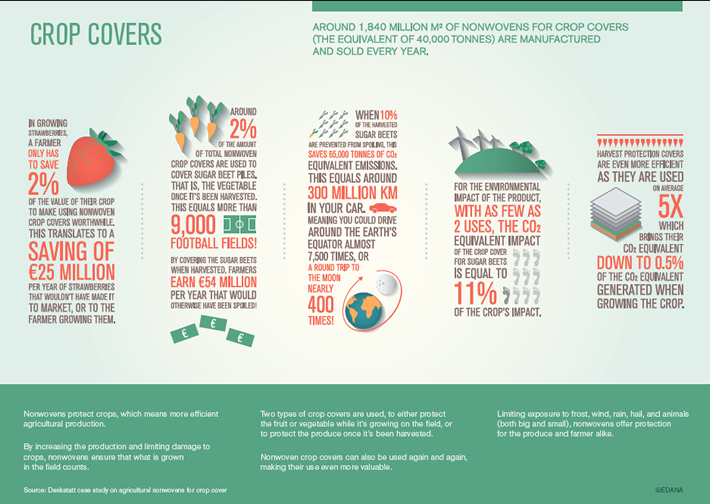
19 May 2014 – Brussels, Belgium – EDANA, the international association serving the nonwovens and related industries, today launched the first two in a series infographics. These images are drawn from a study of the role different types of nonwovens play in our lives, and their effect and impact, highlighting that nonwovens not only play a huge part in our lives, but in how we live them.
Today’s announcement sees nonwovens used in covering for agricultural crops and geotextiles for road construction made available to the public via the EDANA website. (Use the following links to find the original infographics and additional sector/material information.)
Pierre Conrath, Director of Sustainability and Public Affairs said, “EDANA represents the full value nonwovens chain, from raw materials to converted products, and in our industry, we have seen sustainability mature to an ever greater awareness and understanding of the impact and value of products that we use in our lives every day.”

“By studying the impact nonwovens have in areas like crop coverings and road construction, we’re able to see a slice of life that hadn’t previously been studied, which has shown some amazing facts about the value of nonwovens,” continued Conrath.
Around 750 square kilometres of geotextile nonwovens are manufactured and sold every year, 60% of which are used in the construction of roads, however, if all new roads in the EU were built with nonwovens instead of gravel, the savings in CO2 equivalents would equal driving around the earth’s equator nearly 800,000 times. This is because the biggest impact comes from the weight of these materials, with gravel almost 4,000 times heavier than their nonwoven equivalent.
Nonwovens mean a stronger road which can be manufactured with fewer materials. By being lighter, thinner and more resource-efficient than gravel, nonwoven geotextiles offer both an environmental benefit, and cost savings to the user.
Additionally, nonwovens can mean a big difference to the amount of food produced, or prevent spoilage once a crop has been harvested. For example, when growing strawberries, a farmer only has to save 2% of the value of their crop to make using nonwoven covers worthwhile. This can mean a saving of 25 million Euros per year of strawberries that wouldn’t otherwise have made it to market.
Nonwoven crop covers can also be used again and again, and by increasing the production and limiting damage to agricultural crops, nonwovens ensure that what is grown in the field counts.
“Representing the nonwovens and related industries, we have many positive examples to share about our members’ businesses and products,” said Abby Bailey, Director of Marketing and Communications. “These infographics are a new way in which we can help get the story out, and explain the way in which their products help to make our life not only better, but more sustainable.”
The data collected in these studies will be included in the next Sustainability report, due to be released by EDANA around the 4th quarter of 2014.
The infographics will be made available in each of the application areas of the EDANA website: www.edana.org.











